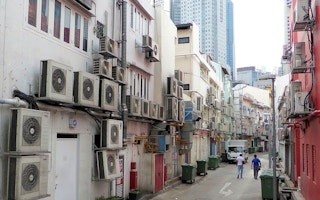One of the ironies of increasing climate change is the cooling crisis: the hotter the planet becomes, the greater our demand for ways to cool down. And most often, in rich countries, that means switching on the air conditioning, which in turn means using more electricity and emitting more fossil fuels to escape the heat we’ve emitted by burning so much already.
Just how serious that irony is in practice is clear from a report by the International Energy Agency (IEA) on the future of cooling. The Agency’s executive director, Fatih Birol, sums up the problem in his foreword: “The world faces a looming ‘cold crunch.’
“Using air conditioners and electric fans to stay cool accounts for nearly 20 per cent of the total electricity used in buildings around the world today. And this trend is set to grow as the world’s economic and demographic growth becomes more focused in hotter countries.”
Since 1990, the report says, global sales of electrically-powered fans and air-conditioning systems (ACs) have more than tripled. More than half of them are used in just two countries—China and the United States. Over a year the 1.6bn ACs in use worldwide consume more than 2,000 terawatt hours (TWh) of electricity—2.5 times more than Africa’s total annual electricity consumption.
Carbon dioxide emissions from cooling have also tripled since 1990, to 1,130m tonnes, causing corresponding growth in local air pollution. And the growing demand for cooling is moving south, driven by economic and population growth in the hottest parts of the world.
Very limited effect
Most of the projected growth by 2050 in energy use for cooling is expected to come from the emerging economies, half of it from three countries—India, China and Indonesia.
The IEA says its analysis shows that governments’ policies to address current and future electricity consumption so as to meet cooling demand would have only “a very limited effect” in slowing it. Its baseline scenario sees the energy needed tripling by 2050 to 6,200 TWh, with meeting peak electricity demand a major challenge, because of the need for extra generation and distribution equipment.
But the baseline scenario is not the only option, the IEA says. Its alternative vision is what it calls an efficient cooling scenario which greatly strengthens policies for limiting the energy needed for cooling, and which it says “is compatible with the ambitious goals to limit climate change that were agreed in the Paris Agreement”.
The key word here is “efficient”. This scenario focuses on achieving massive improvements in the efficiency of AC equipment, accompanied by other measures like tougher minimum energy performance standards, and clear labelling to guide consumers.
If governments altered their policies in this way, the report says, the present average energy efficiency of ACs worldwide could more than double in the next 30 years.
Energy demand for cooling would by 2050 be 45 per cent lower than in the baseline scenario, saving an amount equivalent to all the electricity consumed by the European Union in 2016. And between 2017 and 2050 the efficiency strategy would cost US$2.9 trillion less than the baseline scenario, meaning lower electricity costs for everyone.
Carbon dioxide emissions would, with the decarbonisation of power generation, fall to 13 per cent of their 2016 level, and key air pollutant emissions would fall by up to 85 per cent.
The report says there is potential for even bigger energy savings through changing the way buildings are designed and constructed, and in what materials are used. The idea is not new: across the Middle East there is a long tradition of constructing buildings that incorporate windcatchers, which use natural airflows to ventilate them and have even been used for refrigeration. And just painting buildings white so that they reflect sunlight can help.
The principle of passive building design, which uses natural sources, including wind, solar energy and daylight to cut the amount of energy buildings consume, is being updated and extended and, even in countries as hot as India, is providing useful lessons.
This story was published with permission from Climate News Network.








